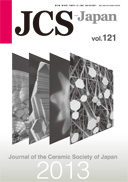116 巻, 1354 号
(June)
選択された号の論文の21件中1~21を表示しています
- |<
- <
- 1
- >
- >|
Reviews
-
2008 年 116 巻 1354 号 p. 665-673
発行日: 2008年
公開日: 2008/06/01
PDF形式でダウンロード (1678K) -
2008 年 116 巻 1354 号 p. 674-680
発行日: 2008年
公開日: 2008/06/01
PDF形式でダウンロード (1175K)
Papers
-
2008 年 116 巻 1354 号 p. 681-684
発行日: 2008年
公開日: 2008/06/01
PDF形式でダウンロード (536K) -
2008 年 116 巻 1354 号 p. 685-687
発行日: 2008年
公開日: 2008/06/01
PDF形式でダウンロード (752K) -
2008 年 116 巻 1354 号 p. 688-693
発行日: 2008年
公開日: 2008/06/01
PDF形式でダウンロード (901K) -
2008 年 116 巻 1354 号 p. 694-699
発行日: 2008年
公開日: 2008/06/01
PDF形式でダウンロード (1472K) -
2008 年 116 巻 1354 号 p. 700-705
発行日: 2008年
公開日: 2008/06/01
PDF形式でダウンロード (1682K) -
2008 年 116 巻 1354 号 p. 706-711
発行日: 2008年
公開日: 2008/06/01
PDF形式でダウンロード (1753K) -
2008 年 116 巻 1354 号 p. 712-716
発行日: 2008年
公開日: 2008/06/01
PDF形式でダウンロード (1264K) -
2008 年 116 巻 1354 号 p. 717-721
発行日: 2008年
公開日: 2008/06/01
PDF形式でダウンロード (795K) -
2008 年 116 巻 1354 号 p. 722-726
発行日: 2008年
公開日: 2008/06/01
PDF形式でダウンロード (472K) -
2008 年 116 巻 1354 号 p. 727-731
発行日: 2008年
公開日: 2008/06/01
PDF形式でダウンロード (1707K) -
2008 年 116 巻 1354 号 p. 732-736
発行日: 2008年
公開日: 2008/06/01
PDF形式でダウンロード (633K) -
2008 年 116 巻 1354 号 p. 737-739
発行日: 2008年
公開日: 2008/06/01
PDF形式でダウンロード (443K) -
2008 年 116 巻 1354 号 p. 740-743
発行日: 2008年
公開日: 2008/06/01
PDF形式でダウンロード (918K) -
2008 年 116 巻 1354 号 p. 744-748
発行日: 2008年
公開日: 2008/06/01
PDF形式でダウンロード (1211K) -
2008 年 116 巻 1354 号 p. 749-754
発行日: 2008年
公開日: 2008/06/01
PDF形式でダウンロード (1281K) -
2008 年 116 巻 1354 号 p. 755-761
発行日: 2008年
公開日: 2008/06/01
PDF形式でダウンロード (663K) -
2008 年 116 巻 1354 号 p. 762-766
発行日: 2008年
公開日: 2008/06/01
PDF形式でダウンロード (837K)
Papers
-
2008 年 116 巻 1354 号 p. 767-770
発行日: 2008年
公開日: 2008/06/01
PDF形式でダウンロード (395K) -
2008 年 116 巻 1354 号 p. 771-775
発行日: 2008年
公開日: 2008/06/01
PDF形式でダウンロード (1035K)
- |<
- <
- 1
- >
- >|
